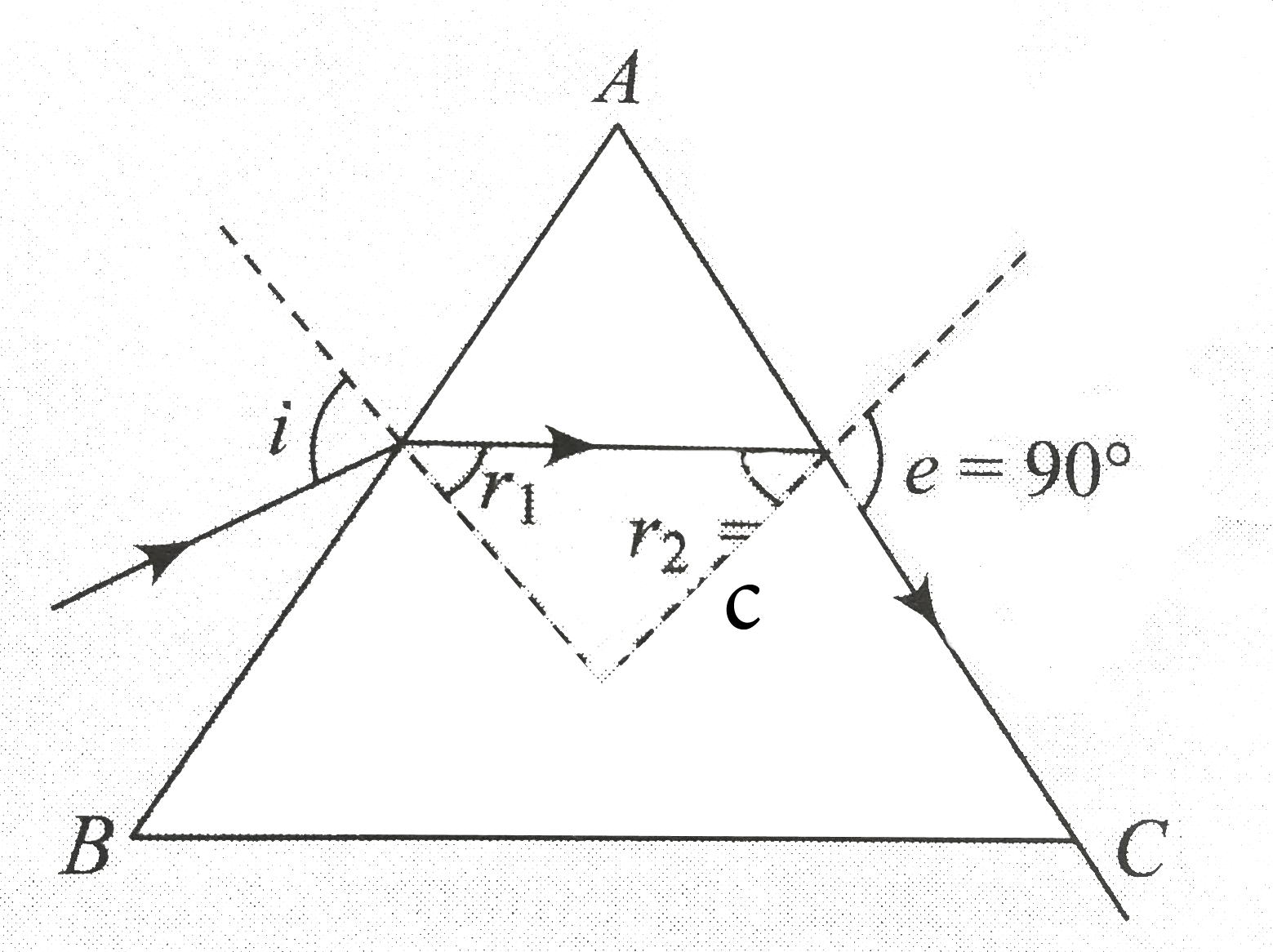The maximum value of refractive index of a prism which permits the transmission of light through it when the refracting angl e of the prism is 90∘, is given by
1.500
1.414
2.000
1.732
The correct Answer is:B
To find the maximum value of the refractive index (μ) of a prism that permits the transmission of light through it when the refracting angle (A) of the prism is 90 degrees, we can follow these steps:
1. Understanding the Geometry of the Prism:
- The refracting angle of the prism is given as A=90∘.
- The prism has two refracting surfaces, and we denote the angles of refraction at these surfaces as R1 and R2.
- According to the geometry of the prism, we have:
R1+R2=A
- Since A=90∘, we can write:
R1+R2=90∘
2. Using Symmetry for Maximum Refractive Index:
- For maximum refractive index, we assume symmetry, which means R1=R2.
- Let R1=R2=R.
- Therefore, we can rewrite the equation as:
2R=90∘
- Solving for R:
R=45∘
3. Condition for Light Transmission:
- For light to pass through the prism without total internal reflection, the angle of refraction R must not exceed the critical angle θc.
- Thus, we have:
R≤θc
- Substituting R=45∘:
45∘≤θc
4. Relating Critical Angle to Refractive Index:
- The critical angle θc is related to the refractive index μ by the formula:
θc=sin−1(1μ)
- Therefore, we can express the condition as:
45∘≤sin−1(1μ)
5. Finding the Sine of the Critical Angle:
- Taking the sine of both sides:
sin(45∘)≤1μ
- We know that sin(45∘)=1√2, so we can rewrite the inequality as:
1√2≤1μ
6. Rearranging to Find Maximum Refractive Index:
- Rearranging gives us:
μ≤√2
- Therefore, the maximum value of the refractive index μ is:
μ=√2
Conclusion:
The maximum value of the refractive index of the prism that permits the transmission of light through it when the refracting angle is 90∘ is √2.
- The refracting angle of the prism is given as A=90∘.
- The prism has two refracting surfaces, and we denote the angles of refraction at these surfaces as R1 and R2.
- According to the geometry of the prism, we have:
R1+R2=A
- Since A=90∘, we can write:
R1+R2=90∘
- For maximum refractive index, we assume symmetry, which means R1=R2.
- Let R1=R2=R.
- Therefore, we can rewrite the equation as:
2R=90∘
- Solving for R:
R=45∘
- For light to pass through the prism without total internal reflection, the angle of refraction R must not exceed the critical angle θc.
- Thus, we have:
R≤θc
- Substituting R=45∘:
45∘≤θc
- The critical angle θc is related to the refractive index μ by the formula:
θc=sin−1(1μ)
- Therefore, we can express the condition as:
45∘≤sin−1(1μ)
- Taking the sine of both sides:
sin(45∘)≤1μ
- We know that sin(45∘)=1√2, so we can rewrite the inequality as:
1√2≤1μ
- Rearranging gives us:
μ≤√2
- Therefore, the maximum value of the refractive index μ is:
μ=√2
The maximum value of the refractive index of the prism that permits the transmission of light through it when the refracting angle is 90∘ is √2.
Topper's Solved these Questions
- REFRACTION OF LIGHTBOOK - DC PANDEY ENGLISHCHAPTER - REFRACTION OF LIGHTEXERCISE - Single Correct Option
3 Videos
- REFRACTION OF LIGHTBOOK - DC PANDEY ENGLISHCHAPTER - REFRACTION OF LIGHTEXERCISE - more than one correct option
1 Videos
- REFRACTION OF LIGHTBOOK - DC PANDEY ENGLISHCHAPTER - REFRACTION OF LIGHTEXERCISE - Subjective Questions
8 Videos
- REFLECTION OF LIGHTBOOK - DC PANDEY ENGLISHCHAPTER - REFLECTION OF LIGHTEXERCISE - Subjective
9 Videos
- SEMICONDUCTORSBOOK - DC PANDEY ENGLISHCHAPTER - SEMICONDUCTORSEXERCISE - Subjective
12 Videos
Similar Questions
Knowledge Check
In refraction of light through a prism the light ray:
Asuffers refraction only at one face of the prismBemergest out from the prism in a direction parallel to the incident rayCbends at both the surface of the prism towards its baseDbends at both the surfaces of the prism opposite to its base.
A thin prism having refracting angle 10∘ is made of glass of refracting index 1.42. This prism is combined with another thin prism of glass of refractive index 1.7. This combination produces dispersion without deviation. The refracting angle of second prism should be :
View SolutionThe maximum refractive index of a material, of a prism of apex 90∘ , for which light may be transmitted is
View SolutionThe refractive index of the material of a prism is √2 and the angle of the prism is 30∘. One of the two refracting surfaces of the prism is made a mirror inwards, by silver coating. A beam of monochromatic light entering the prism from the other face will retrace its path (after reflection from the silvered surface) if its angle of incidence on the prism is
View SolutionA small angled prism of refractive index 1.4 is combined with another small angled prism of refractive index 1.6 to produce disperison without deviation. If the angle of first prism is 6(∘), then the angle of the second prism is
View SolutionThe least angle of deviation for a glass prism is equal to its refracting angle. The refractive index of glass is 1.5. Then the angle of the prism is
View SolutionThe least angle of deviation for a glass prism is equal to its refracting angle. The refractive index of glass is 1.5. Then the angle of the prism is
View SolutionWhat should be the minimum value of refractive index of a prism, refracting angle A, so that there is no emergent ray irrespective of the angle of incidence?

View Solution
